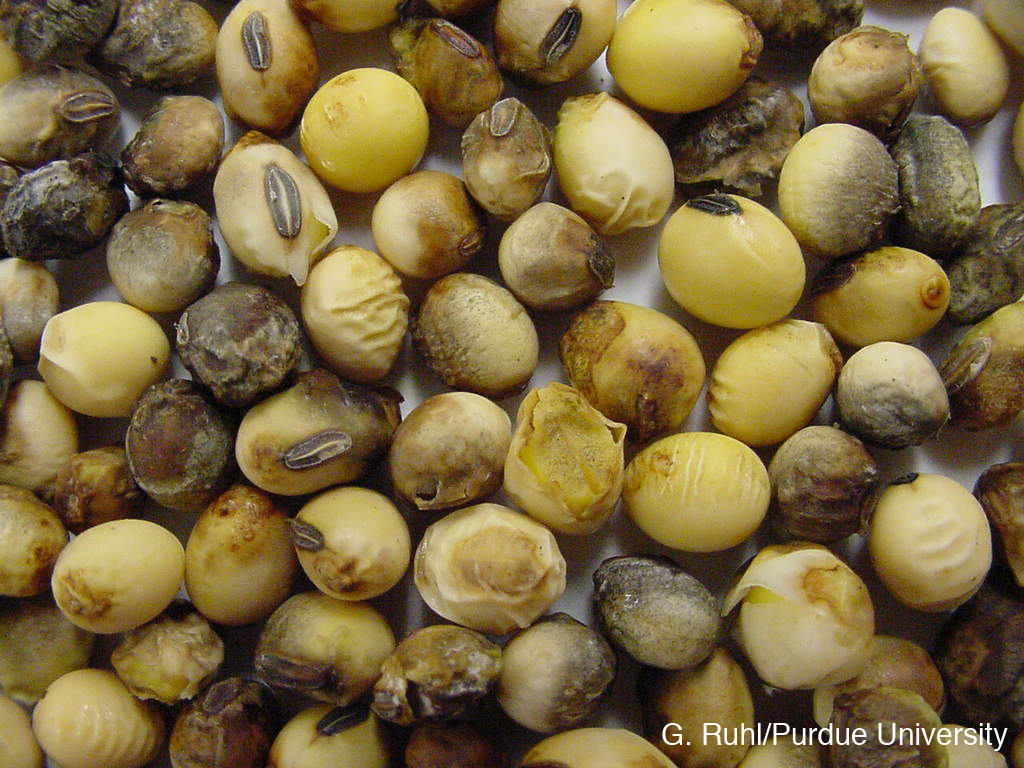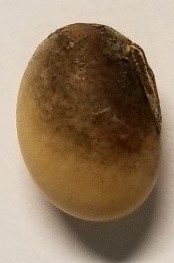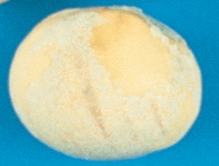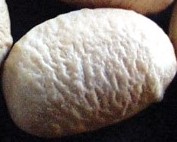There are a number of fungal soybean diseases that can greatly impact seed quality. In Indiana, the most common are Phomopsis seed decay (Phomopsis spp.), Cercospora purple seed stain (Cercospora kikuchii); Frogeye leaf spot on seed (Cercospora sojina); Anthracnose (Colletotrichum spp.); Downy mildew (Pernospora manshurica); and various other secondary fungal invaders of injured pods including Alternaria, Fusarium, Cladosporium, and Penicillium.
The tables below provides several descriptive characteristics to begin the diagnostic process and choose appropriate management recommendations. It is important to note, however, that although Purple Seed Stain is easily identified by the ‘signature’ purple symptom on the seed, accurate diagnosis of most of the fungal diseases on seed requires microscopic assistance offered by the Purdue Plant and Pest Diagnostic Laboratory (PPDL). The diversity of symptoms that can be observed on diseased soybean seed is shown in the example in Figure 1. In this image, all of the discolored seed were incubated and microscopically confirmed to be infected with the frogeye leaf spot pathogen C. sojina.
Disease infected seed can have reduced storability, decreased germination, loss of seed weight and reduced meal and oil quality. Optimum storage conditions to limit fungal growth includes 1. Seed free from fungi or other pests, 2. Clean seed without organic or other waste material, 3. Less than 12% moisture, and 4. Cool uniform storage temperature.
Management options to minimize diseases on soybean seed:
- Start with clean seed (pathogen free) and use resistant varieties when available.
- Fungicide options –
- Seed treatments can help reduced seed to seedling disease transfer.
- Foliar fungicides can help reduced the risk to pod and seed infection by some fungi.
- Tillage and crop rotation – bury the inoculum from disease-infested residue and further reduced the inoculum by planting a non-host the next season.
- When at threshold levels, control pests, such as bean leaf beetle, and other insects that injure the pod, opening the door to fungal infection (see https://extension.entm.purdue.edu/newsletters/pestandcrop/article/discolored-and-shriveled-soybean-seeds-who-done-it/)
References:
Bradley, C. et. al. 2016. Frogeye Leaf Spot. Crop Protection Network. CPN-1017.
Hartman, G. L. et al. eds. 2015. Compendium of Soybean Diseases and Pests, 5th ed. American Phytopathological Society, St. Paul, MN.
Mueller, D. et al. 2015 Scouting White Mold Soybean. Crop Protection Network. CPN – 1010B.
Mueller, D. et al. eds. 2016. A Farmer’s Guide to Soybean Diseases. American Phytopathological Society, St. Paul, MN.
Tenuta, A. et al. 2015. Scouting for Common Soybean Seed Diseases. Crop Protection Network. CPN-1001B.

Figure 1. A diverse range of symptoms observed from Cercospora sojina (frogeye leaf spot) infection on seed. (Photo Credit: Gail Ruhl, PPDL).
Table 1. Characteristics and management options for fungal diseases of soybean that affect seed quality.
Table 2. Stem diseases that might lead to contaminated seed lots.
Image credit: 1University of Missouri Extension. 2Purdue Plant Pest Diagnostic Lab. 3Darcy Telenko, Purdue University. 4Courtesy J. B. Sinclair – ©APS. Reproduce, by permission, from Hartman, G. L. et al. eds. 2015. Compendium of Soybean Diseases and Pests, 5th ed. American Phytopathological Society, St. Paul, MN. 5Albert Tenuta. Reproduced, by permission, from Mueller, D. et al. eds. 2016. A Farmer’s Guide to Soybean Diseases. American Phytopathological Society, St. Paul, MN.








